![]()
(*) Thank you to Father Stalin for depriving us of food.
Our mother died of hunger and we ate her, our own dead mother.The dreadful famine that engulfed Ukraine, the northern Caucasus, and the lower Volga River area in 1932-1933 was the result of Joseph Stalin's policy of forced collectivization. The heaviest losses occurred in Ukraine, which had been the most productive agricultural area of the Soviet Union. Stalin was determined to crush all vestiges of Ukrainian nationalism. Thus, the famine was accompanied by a devastating purge of the Ukrainian intelligentsia and the Ukrainian Communist party itself. The famine broke the peasants' will to resist collectivization and left Ukraine politically, socially, and psychologically traumatized.
The policy of all-out collectivization instituted by Stalin in 1929 to finance industrialization had a disastrous effect on agricultural productivity. Nevertheless, in 1932 Stalin raised Ukraine's grain procurement quotas by forty-four percent. This meant that there would not be enough grain to feed the peasants, since Soviet law required that no grain from a collective farm could be given to the members of the farm until the government's quota was met. Stalin's decision and the methods used to implement it condemned millions of peasants to death by starvation. Party officials, with the aid of regular troops and secret police units, waged a merciless war of attrition against peasants who refused to give up their grain. Even indispensable seed grain was forcibly confiscated from peasant households. Any man, woman, or child caught taking even a handful of grain from a collective farm could be, and often was, executed or deported. Those who did not appear to be starving were often suspected of hoarding grain. Peasants were prevented from leaving their villages by the NKVD (secret police) and a an internal passport system was implemented to restrict movements of Ukrainian peasants so that they could not travel in search of food .
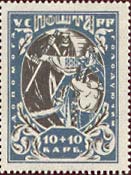 |
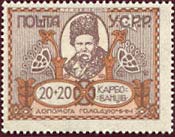 |
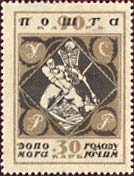 |
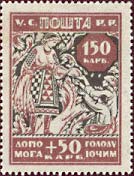 |
The death toll from the 1932-33 famine in Ukraine has been estimated between six million and seven million. According to a Soviet author, "Before they died, people often lost their senses and ceased to be human beings." Yet one of Stalin's lieutenants in Ukraine stated in 1933 that the famine was a great success. It showed the peasants "who is the master here. It cost millions of lives, but the collective farm system is here to stay." The actions of this Moscow instigated action was a deliberate act of genocide against the Ukrainian peasant. Source
In June 1923; the Ukrainian Soviet Socialist Republic government issued a set of four semi-postal stamps, Scott SP1 - SP4. As semi-postal stamps, part of the revenue from their sale was earmarked for relief caused by an economic collapse and famine in the Soviet Union during the years 1921-22. The surcharge on these stamps was intended for famine victims. These stamps were in circulation for less than a month. Respectively, these stamps are titled Famine, Taras Shevchenko, Death Stalking Peasant and Ukraine Distributing Food.
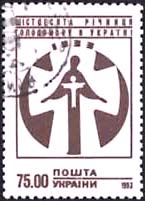 |
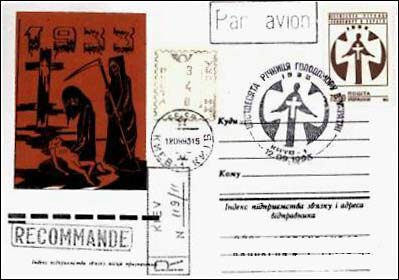 |
Issued 12 September 1993, the 75k stamp featuring the 60th Anniversary - Great Famine (1933 - 1934) stamp (Scott 188), shows a female form with a silhouette of a child on a white Cossack cross. A postally used First Day Cover is also displayed above.
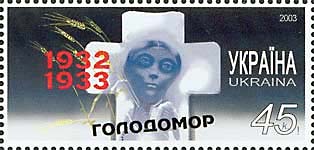 |
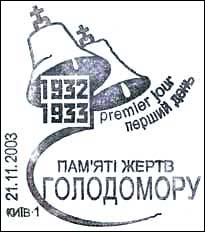 |
Marka Ukrainy, the stamp publishing company of the Ukraine postal service, Ukrposhta, issued a new holodomor stamp on Friday, November 21, in memory of 70th anniversary of the millions of victims of the death and terror by famine in Ukraine in 1932-1933. The new stamp features an old style white stone cross with the facial image of a starving child in the center of the cross. To the left of the cross are the dates 1932-1933 in red letters with a few heads of wheat.
On the right of the cross is the word Ukraina in white letters. At the bottom of the cross in black letters is the word "holodomor" which in Ukrainian means to kill by hunger, or torture with hunger and terror. Such information was not allowed publicly or officially in Soviet Ukraine until the late 1980's. The first large commemoration activities took place in 1993 after Ukraine declared its independence in August of 1991 and the Soviet Union collapsed.
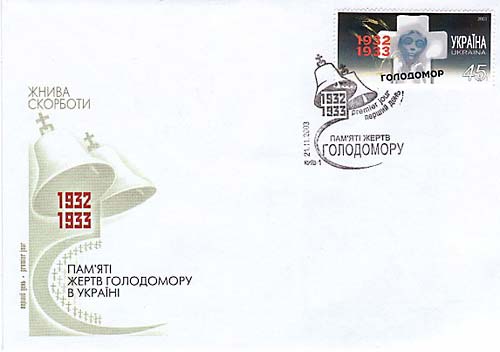
The holodomor stamp shown above was the second version of the 2003 stamp. The first version (see below) featured a family of five famine victims. What was really troubling about the image was the starving peasants on the left side of the stamp. The figures of three women, a baby, and a girl with a swollen belly came from a 1921 famine photograph. Not only that the photo was taken more than 10 years before the 1930s famine, but it pictured Russian peasants from Buzulak in Soviet Russia, not Ukraine. A subsequent minor alteration to the stamp design did away with the three famine dates, but did not really eliminate the clutter and still retained the unsuitable figures. After information became available that the photograph on the stamp was of a Russian family taken during the Soviet famine in 1921, Marka Ukrainy decided to redesign the holodomor stamp. Source
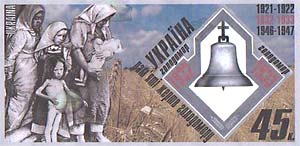 |
 |
In Memory of Victims of Holodomor. 1921-1922, 1932-1933, 1946-1947 and In Memory of Victims of Holodomor 1932-1933
The Ukrainian famines were among the first ones of the 20th century, provoked by the criminal policies introduced and spread worldwide by the Communist Party of the Soviet Union. They will continue everywhere in the world where similar policies (like expropriation of soil and tools of production, forced movements of populations, centralized planning of production, etc.) will be applied. These men-provoked famines will be also used as a mean of misappropriation of the Western humanitarian aid, especially on the African continent.
